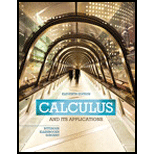
For Exercises 69–84, draw a graph to match the description given. Answers will vary.
has a positive derivative over
and a negative derivative over
Trending nowThis is a popular solution!

Chapter 2 Solutions
Calculus and Its Applications (11th Edition)
Additional Math Textbook Solutions
Calculus: Early Transcendentals (2nd Edition)
University Calculus: Early Transcendentals (4th Edition)
Precalculus Enhanced with Graphing Utilities (7th Edition)
Glencoe Math Accelerated, Student Edition
- Exercises 121–140: (Refer to Examples 12–14.) Complete the following for the given f(x). (a) Find f(x + h). (b) Find the difference quotient of f and simplify. 121. f(x) = 3 122. f(x) = -5 123. f(x) = 2x + 1 124. f(x) = -3x + 4 %3D 125. f(x) = 4x + 3 126. f(x) = 5x – 6 127. f(x) = -6x² - x + 4 128. f(x) = x² + 4x 129. f(x) = 1 – x² 130. f(x) = 3x² 131. f(x) = 132. /(x) 3D글 = = 132. f(: 133. f(x) = 3x² + 1 134. f(x) = x² –- 2 135. f(x) = -x² + 2r 136. f(x) = -4xr² + 1 137. f(x) = 2x - x +1 138. f(x) = x² + 3x - 2 139. f(x) = x' 140. f(x) = 1 – xarrow_forwardIn Exercises 11–18, graph each function by making a table of coordinates. If applicable, use a graphing utility to confirm your hand-drawn graph. 11. f(x) = 4" 13. g(x) = ()* 15. h(x) = (})* 17. f(x) = (0.6) 12. f(x) = 5" 14. g(x) = () 16. h(x) = (})* 18. f(x) = (0.8)* %3!arrow_forwardIn Exercises 73–78, the graph of f is shownin the figure. Sketch a graph of the derivative of f. To print anenlarged copy of the graph, go to MathGraphs.com.image5arrow_forward
- Use Definition 0.10 to show that each pair of functions in Exercises 67–70 are inverses of each other. 1 2 67. f(x) =2 – 3x and g(x) = -x+ 3 68. f(x) = x² restricted to [0, 0) and g(x) = V 69. f(x) = and g(x) = 1+x 1-x 1 1 70. f(x) = and g(x) 2x 2xarrow_forwardFor Exercises 75–84, determine the r- and y-intercepts for the given function. (See Example 7) 75. f(x) = 2x – 4 76. g(x) = 3x – 12 77. h(x) = |x| – 8 78. k(x) = -|x| + 2 79. p(x) = -x + 12 80. q(x) = - 8 81. r(x) = |x – 8| 82. s(x) = |x + 3| 83. f(x) = Vx – 2 84. g(x) = – Vx + 3arrow_forwardIn Exercises 139–142, determine whether each statement is true or false. If the statement is false, make the necessary change(s) to produce a true statement. log, 8 8 140. log(-100) = -2 139. log, 4 141. The domain of f(x) = log, x is (-0∞, ∞). 4 142. log, x is the exponent to which b must be raised to obtain x.arrow_forward
 Calculus: Early TranscendentalsCalculusISBN:9781285741550Author:James StewartPublisher:Cengage Learning
Calculus: Early TranscendentalsCalculusISBN:9781285741550Author:James StewartPublisher:Cengage Learning Thomas' Calculus (14th Edition)CalculusISBN:9780134438986Author:Joel R. Hass, Christopher E. Heil, Maurice D. WeirPublisher:PEARSON
Thomas' Calculus (14th Edition)CalculusISBN:9780134438986Author:Joel R. Hass, Christopher E. Heil, Maurice D. WeirPublisher:PEARSON Calculus: Early Transcendentals (3rd Edition)CalculusISBN:9780134763644Author:William L. Briggs, Lyle Cochran, Bernard Gillett, Eric SchulzPublisher:PEARSON
Calculus: Early Transcendentals (3rd Edition)CalculusISBN:9780134763644Author:William L. Briggs, Lyle Cochran, Bernard Gillett, Eric SchulzPublisher:PEARSON Calculus: Early TranscendentalsCalculusISBN:9781319050740Author:Jon Rogawski, Colin Adams, Robert FranzosaPublisher:W. H. Freeman
Calculus: Early TranscendentalsCalculusISBN:9781319050740Author:Jon Rogawski, Colin Adams, Robert FranzosaPublisher:W. H. Freeman
 Calculus: Early Transcendental FunctionsCalculusISBN:9781337552516Author:Ron Larson, Bruce H. EdwardsPublisher:Cengage Learning
Calculus: Early Transcendental FunctionsCalculusISBN:9781337552516Author:Ron Larson, Bruce H. EdwardsPublisher:Cengage Learning





